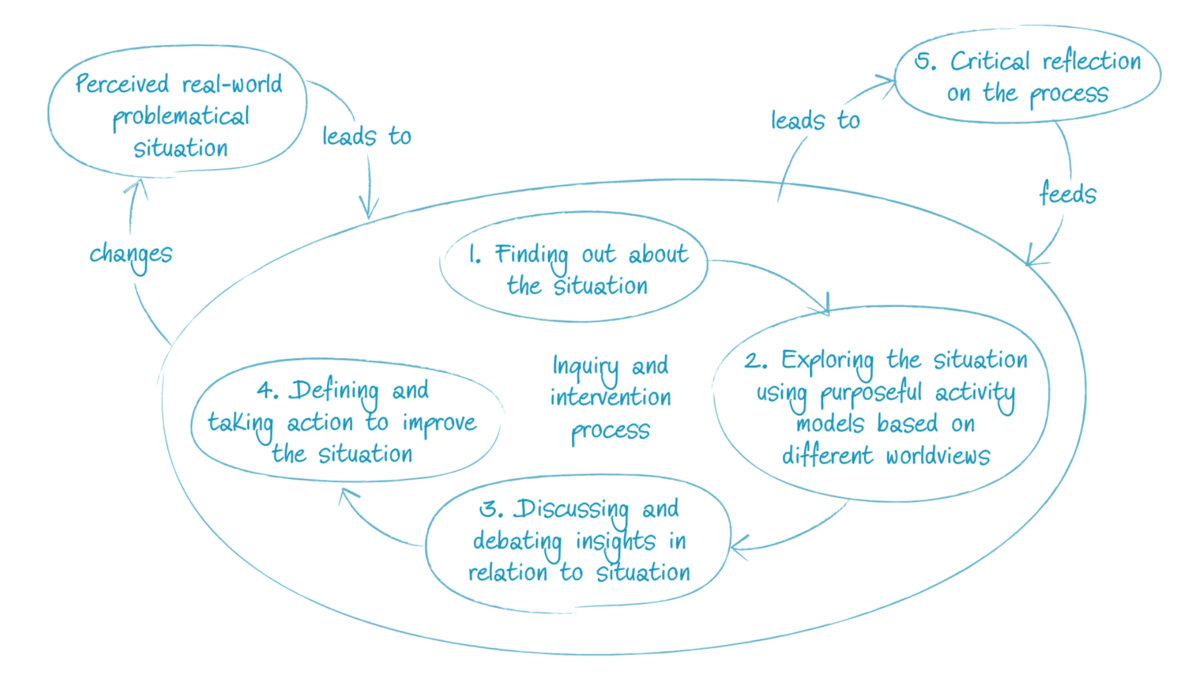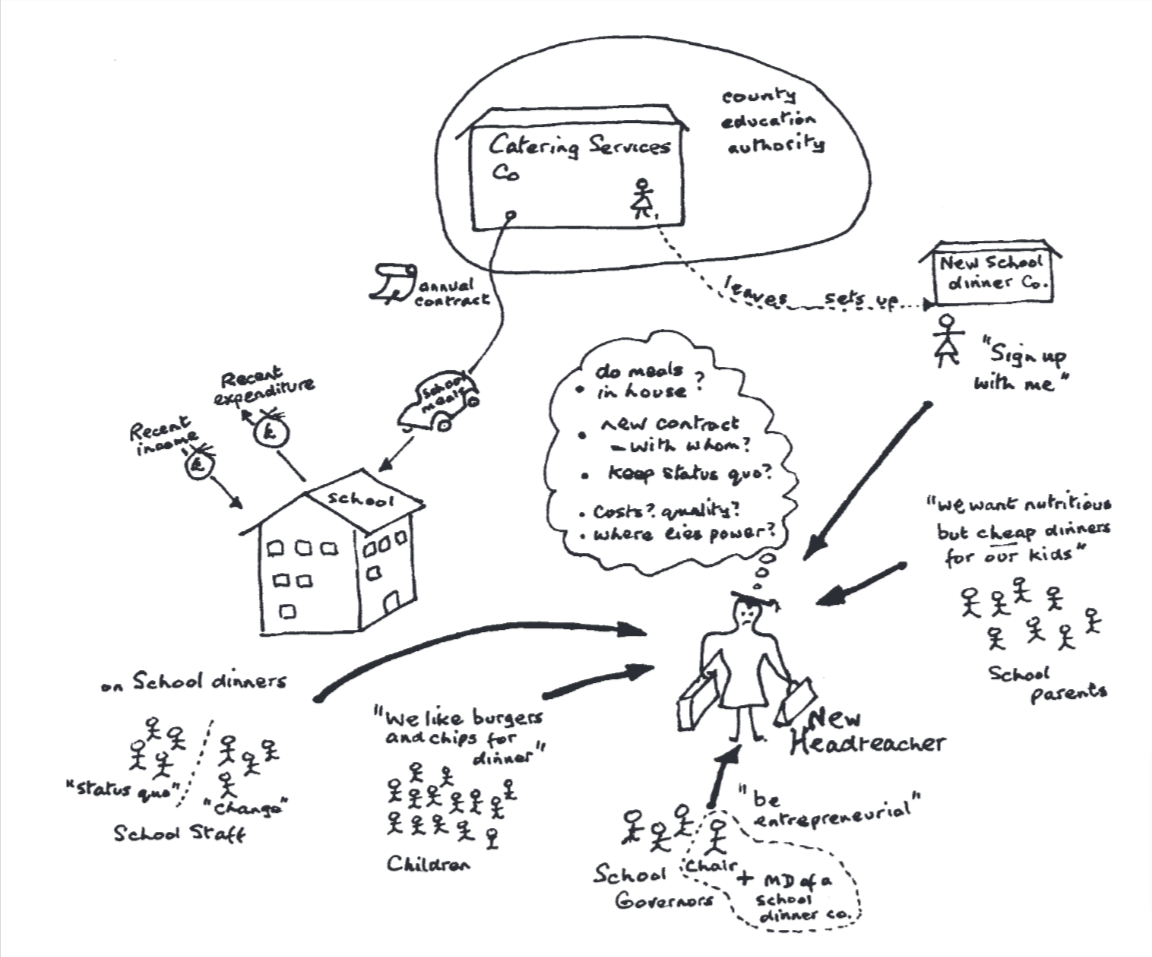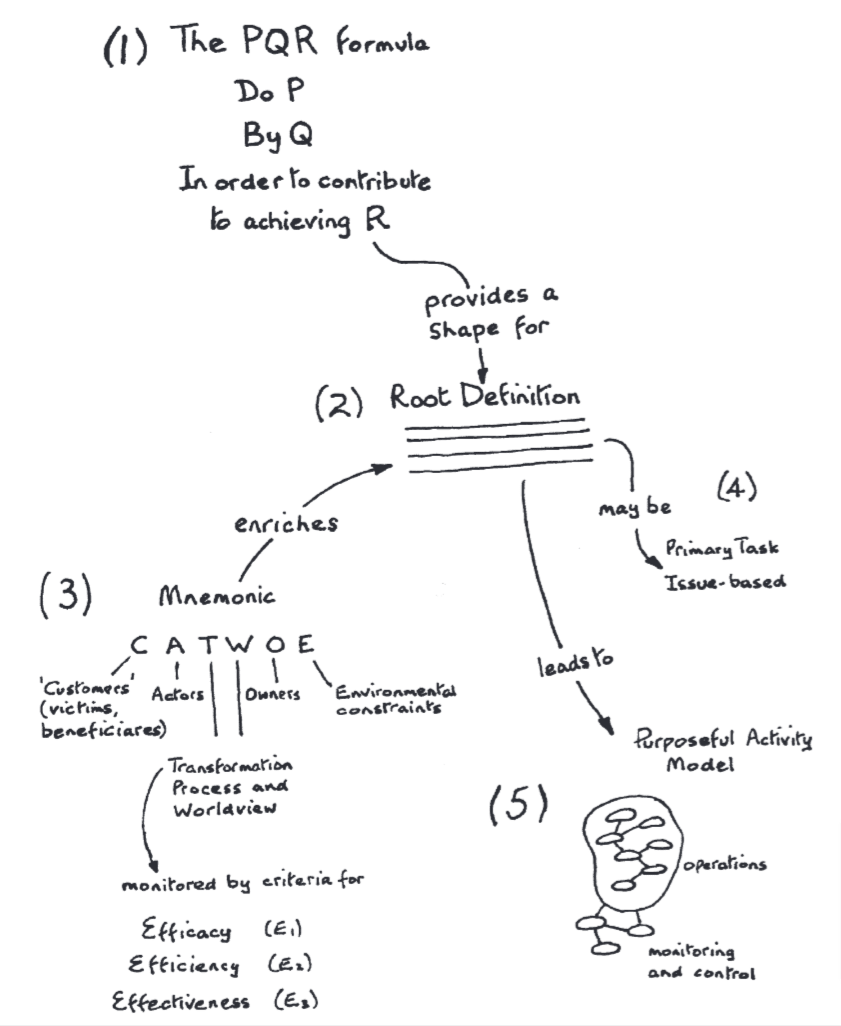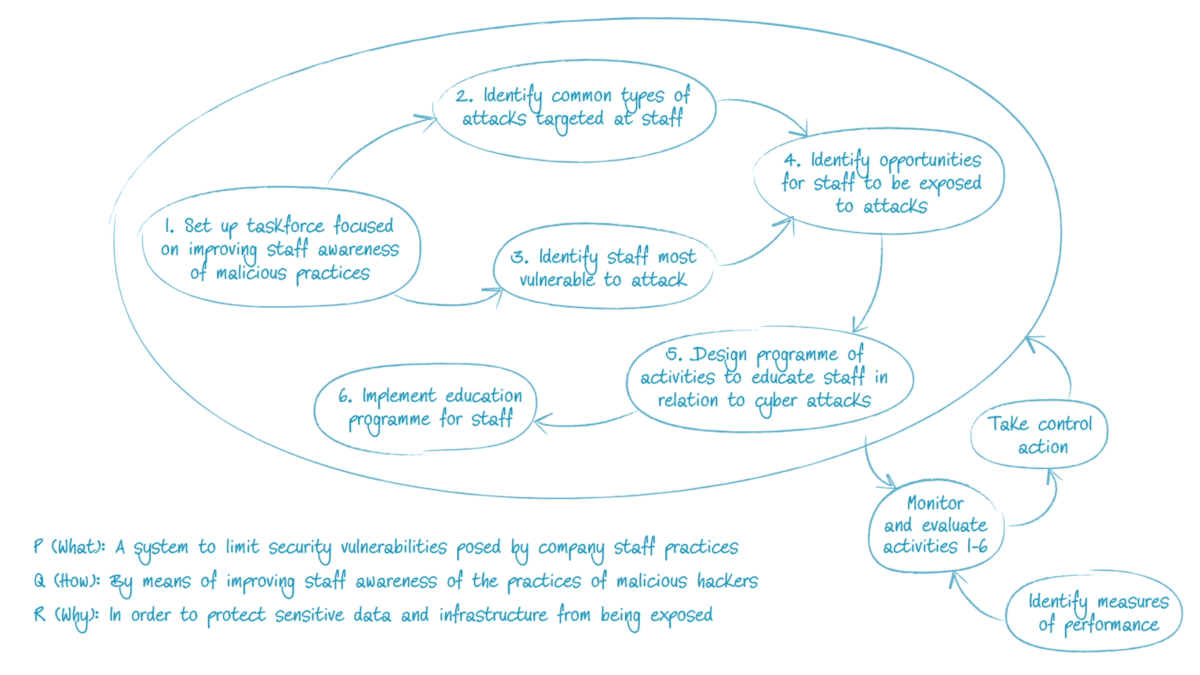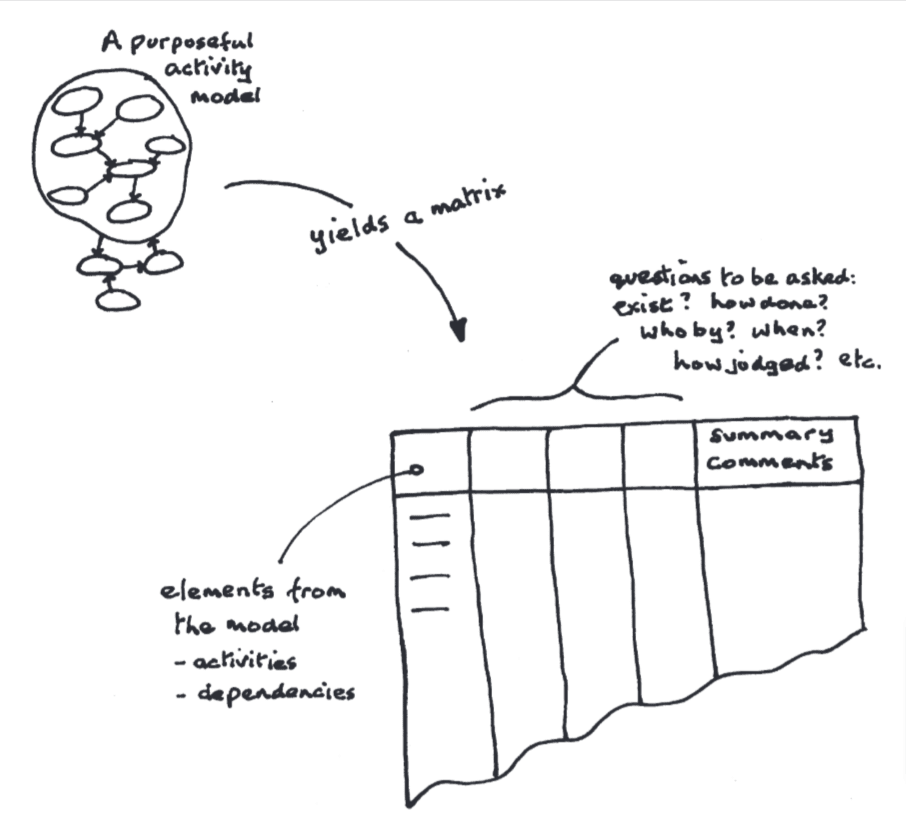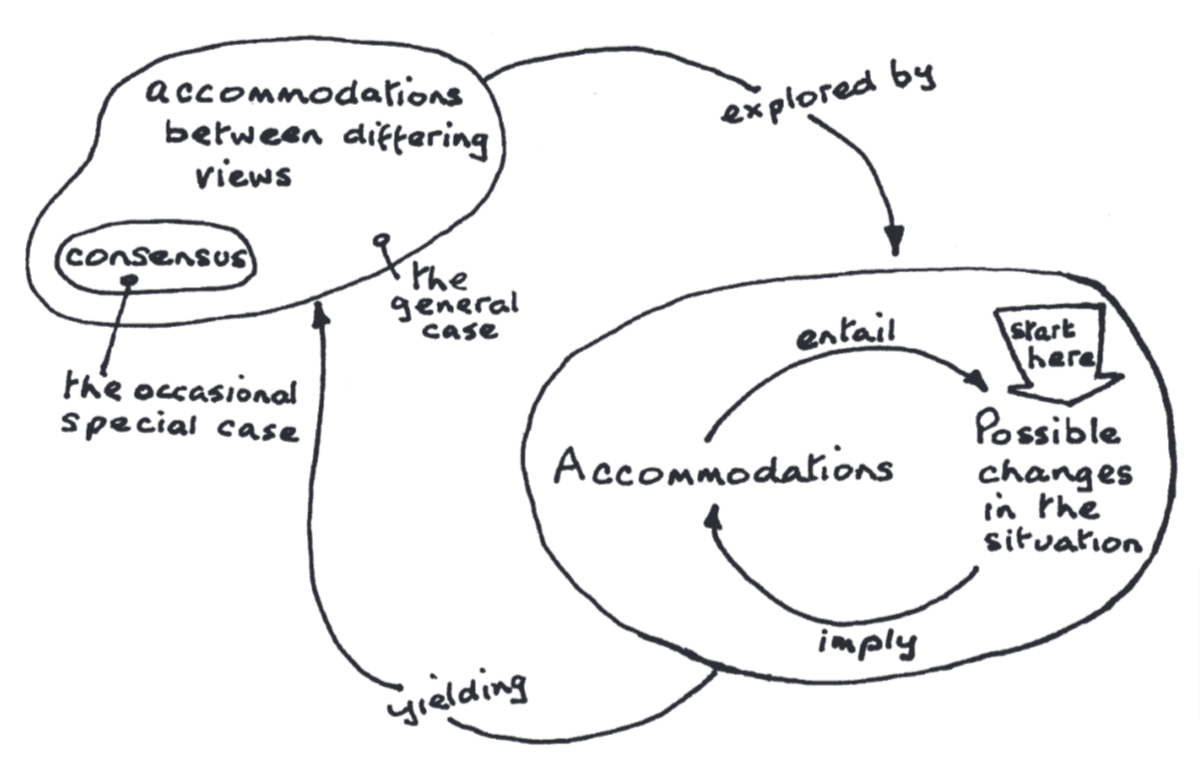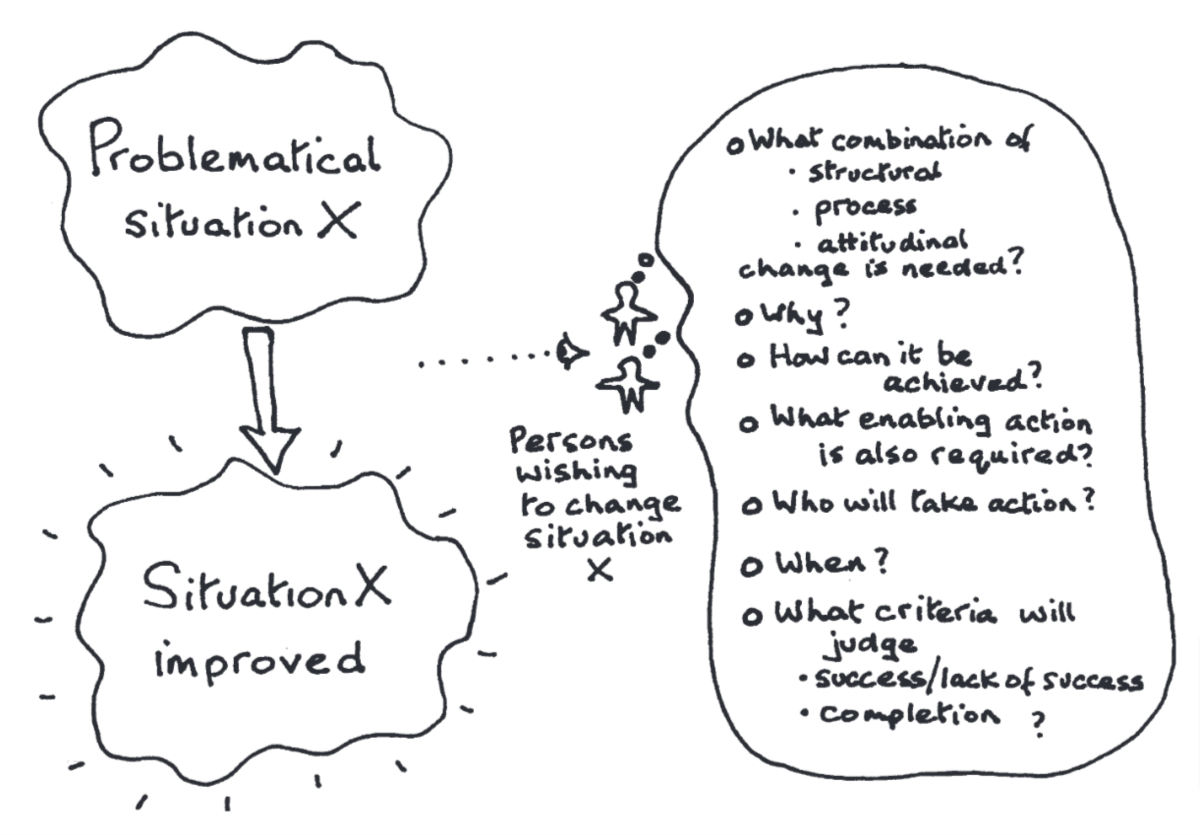TB871: An overview of Soft Systems Methodology (SSM)
Note: this is a post reflecting on one of the modules of my MSc in Systems Thinking in Practice. You can see all of the related posts in this category.
In this post, I’m going to explain SSM at a high level, using diagrams from a video which forms part of the module materials (The Open University, 2020) and from Chapter 5 of Systems Approaches to Making Change, one of the course texts. I’ll include examples, but I’m not going to apply it to just one particular situation.
Overview
We identify a real-world situation which is perceived as ‘problematical’ and start an inquiry and intervention process made up of:
- Finding out about the situation
- Exploring the situation using purposeful activity models based on different worldviews
- Discussing and debating insights in relation to the situation
- Defining and taking action to improve the situation
This, in turn, changes perceptions of the situation. Meanwhile, we critically reflect on the process which feeds further insights.
0. The role of the systems thinking practitioner
It’s important to note that the systems thinking practitioner is not a neutral observer:
The practitioner is someone who brings their own values, expectations, and biases. They are partial, and crucially are part of the situation.
1. Finding out about the situation
To get started with SSM, we create a ‘rich picture’. This is an diagram which can be created individually or in a group setting:
In making a Rich Picture the aim is to capture, informally, the main entities, structures and viewpoints in the situation, the processes going on, the current recognized issues and any potential ones. (Checkland & Poulter, 2006, p.219)
The following example depicts a decision that a new headteacher has to make about whether to provide school meals in-house, or outsource them.
Rich pictures help us build models of a situation as they provide a basis for conversation and different ways of looking at the problematical situation.
As I mentioned in a previous post, the systems thinking practitioner now performs three different analyses to create a purposeful activity model:
- Analysis One: identifying the client, practitioner, and issue owners
- Analysis Two: exploring the roles, norms, and values within the situation
- Analysis Three: examining power dynamics and political aspects
Let’s look at each of these in turn.
Analysis One
In the first analysis, we figure out who:
- Caused the intervention to happen (the client)
- Conducts the investigation (the practitioner)
- Constitute the people who are concerned about or affected by the situation (owner(s) of the issue(s) addressed, or owner)
Note that these are roles. For example, the headteacher in the rich picture above could be the client, practitioner, and the owner. It’s more usual, though, for the client being someone with responsibility within an organisation, the practitioner to be some form of external consultant, and the owner to be stakeholders.
Analysis Two
In the second analysis, we figure out the socio-cultural context within which the problematical situation exists. This is done by figuring out the following:
- Roles — social positions that distinguish individuals within a group or organisation, which can be formal (e.g. chief executives) or informal (e.g. being known as a ‘rebel’)
- Norms — expected behaviours that define a role (e.g. people behaving appropriately in formal and informal situations)
- Values — standards used to judge behaviour within a role (e.g. she’s an efficient product manager who runs meetings well)
It’s worth noting that these are not static elements of an organisation or situation, and that they interact with one another. Performing this analysis is as simple as (i) creating a table, placing roles, norms, and values along the top, (ii) identifying the various roles, (iii) filling in the rest of the boxes in the ‘norms’ and ‘values’ columns.
Analysis Three
In the third analysis, we look at politics and power. This is done by figuring out what is ‘desirable’ and ‘culturally feasible’. The latter point is important, and (to my mind) is much like the Overton Window when thinking about a range of policies acceptable to the mainstream population at any given time. It’s also similar to the consent-based decision making we used in our co-op.
Analysis Three uses the metaphor of a ‘commodity’ that represents power. It identifies the ‘commodities’ indicating power and explores how these are obtained, used, protected, and transferred. For example, power can come from commodities such as:
- Personal charisma
- Membership of a particular group
- Access to influential individuals or informatoin
- Intellectual authority
- Control over communications
Again, this analysis can be performed by creating a simple table listing the various commodities of power, and how they are obtained, used, transferred, protected, defended, and relinquished.
2. Exploring the situation using purposeful activity models based on different worldviews
The next step builds on the rich picture(s) and analyses from the previous step. Systems practitioners use the PQR Formula and the CATWOE mnemonic to create a Root Definition.
The diagram below shows how it’s possible to create a very structured purposeful activity model by using the PQR Formula and the CATWOE mnemonic. This example is related to cybersecurity and comes from the module materials.
P can be thought of as ‘what’, while Q is ‘how’ and R is ‘why’. The CATWOE mnemonic helps inform and enrich the diagram, enabling a root definition such as:
A senior management-owned system operated by IT and company staff for the benefit of company senior management to limit security vulnerabilities posed by company staff practices. This improvement in security is done by means of improving staff awareness of the practices of malicious hackers in order to protect sensitive data and infrastructure from being exposed. This is guided by the belief that each organisation has a responsibility for the security of its sensitive data and infrastructure and to protect it from malicious actors. It takes into account constraints surrounding budget, time, and motivation of staff, and buy-in from senior management. (The Open University, 2020)
We can now construct a purposeful activity model to show how we might intervene in the problematical situation. Note that this includes a monitoring function to the bottom-right of the diagram focused on:
- Efficacy: measures whether an activity or intervention achieves its intended outcome.
- Efficiency: assesses how well resources (time, money, effort) are used to achieve the desired outcome.
- Effectiveness: evaluates how well an activity or intervention is successful in achieving stated goals.
Unlike other approaches such as the Viable System Model (VSM) in ‘design’ mode, purposeful activity models are not meant to be aspirational constructs:
The models do not purport to be accounts of what we would wish the real world to be like. They could not, since they are artificial devices based on a pure worldview, whereas human groups are always characterized by multiple conflicting worldviews (even within one individual!) which themselves change over time – sometimes slowly, sometimes remarkably quickly. (Checkland & Poulter, 2006, p.236)
3. Discussing and debating insights in relation to the situation
It’s hard enough to be able to explain quickly and succinctly the differences between the similarly-sounding terms efficacy, efficiency, and effectiveness, never mind answering performance-related questions about them in a complex and problematical situation. This is why we need an organised monitoring process which can uncover underlying implicit worldviews, prompt the development of new models, and stimulate discussion by challenging assumptions.
This process can be carried out informally, but it’s also possible to use a table (or ‘matrix’) to systematically address questions in a more formal way.
Whichever way the models are used to structure discussion, the aim is the same: to find a version of the real situation and ways to improve it which different people with different worldviews can nevertheless live with. Outside of the arbitrary exercise of power, this is the necessary condition which must be met in any human group if agreed ‘action to improve’ is to be defined.
[…]
[I]n order to cope with the complexity of human affairs, SSM uses a much more subtle idea than ‘consensus’. It works with the idea of finding an accommodation among a group of people with a common concern. This does not abandon the possibility of consensus; rather it subsumes it in the more general idea of accommodation. (Checkland & Poulter, 2006, p.239-240)
This idea of ‘accommodation’ is what I have referred to above in relation to the consent-based decision making of Sociocracy. Everyone has both needs and preferences, and distinguishing between the two is important.
4. Defining and taking action to improve the situation
As discussions using purposeful activity models progress, worldviews may be revealed, positions may shift, and potential accommodations might arise. These accommodations require changes to make the situation less problematic, and the focus should shift to identifying changes that are both desirable and culturally feasible.
Significant changes often involve altering structures, processes, and attitudes. Structural changes are relatively easy to implement, but usually need new processes and attitudes — which are more challenging to achieve). While structures can be changed by authority, altering processes and attitudes is more complex and less predictable.
Two final points in relation to the above diagram:
- Enabling actions: any attempts to improve a problematical situation may require other, enabling actions, which are not part of the change itself (i.e. to change the social context)
- Success criteria: how will ‘success’ or ‘completion’ of the intervention in the problematical situation be judged? by whom?
SSM is a never-ending learning process which focuses on practical, focused, interventions within a situation which is perceived as problematical. It helps foreground worldviews and biases, using diagrams to help with this. It is a methodology, rather than a ‘method’ or technique. That means “it is a set of ongoing principles which can be adapted for use in a way which suits the specific nature of each situation in which it is used” (Ibid., p.212). It’s specific enough to be a useful guide, but generic enough to be useful in any situation where people want to take action to improve a situation they regard as problematical.
References
- Checkland, P. & Poulter, J. (2006) ‘Soft Systems Methodology’, in Reynolds, M. and Holwell, S. (eds.) Systems approaches to making change: a practical guide. 2nd edn. Milton Keynes: The Open University/London: Springer, pp.201-253.
- The Open University (2020) ‘5.2.1 Understanding relative perplexity’, TB871 Block 5 Tools stream [Online]. Available at https://learn2.open.ac.uk/mod/oucontent/view.php?id=2261499§ion=3.1 (Accessed 10 August 2024).

